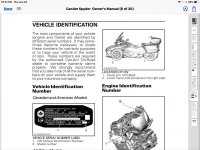WDAVEY
Member
Let me offer a variation of an explanation above that may help you understand why the procedure is what it is. Think of a tank with three connections. One is at the top where oil is pumped into the tank from a small pool in the sump under the crankshaft. The second one is at the bottom that connects to the oil pump so oil from the tank is pumped through all the engine parts. The third is a small connection to the sump under the crankshaft. When the engine is running the oil sucked up from the sump is the same flow rate as the oil that drains to the sump via the small connection plus the oil pumped throughout the engine. The oil pumped throughout the engine drains down to the sump. When you shut down the engine the oil flow via the pumps into and out of the tank stops. But oil continues to drain down to the sump through the small connection. Checking the oil level in the sump wouldn't work because it keeps going up as the tank drains down. Checking oil level in the tank works as long as you check within a short time after shutting off the engine. If you wait too long the tank will drain down and oil level will be low. In fact, if you wait a really long time, like a few months, the oil in the tank will drain down so far it won't touch the dipstick.
So the reason for running the engine for awhile first and then checking within a couple of minutes is to make sure the oil flow, i.e., the amount going into and out of the tank, has been stabilized and then is measured before it drops very much. The high and low points on the dip stick are the oil levels in the tank the engine designers have determined provide the ideal amount of oil for the engine to function properly.
Two points: 1) Harleys have had dry sumps for decades. If you let one sit for extended periods the oil will drain from the tank into the crankcase. Unsuspecting owners fill the tank before starting the engine and blow oil all over the place! This issue is not a BRP only phenomenon. 2) The reason to idle for 10 minutes after the 9 mile ride is to allow oil that was trapped in the upper sections of the engine and trans to drain to the low points so the scavenger pumps can pump it back to the tank. This is probably only a concern after "spirited" riding.

